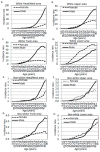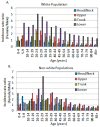Race-, Age-, and Anatomic Site-Specific Gender Differences in Cutaneous Melanoma Suggest Differential Mechanisms of Early- and Late-Onset Melanoma
- PMID: 30871230
- PMCID: PMC6466415
- DOI: 10.3390/ijerph16060908
Race-, Age-, and Anatomic Site-Specific Gender Differences in Cutaneous Melanoma Suggest Differential Mechanisms of Early- and Late-Onset Melanoma
Abstract
In order to explore melanoma risk factors through gender-, age-, race-, and site-specific incidence rates, malignant melanoma cases from the Caucasian whites and non-whites were retrieved from the US SEER database. Age-standardized, age-, and site-specific tumor rates were calculated. All races and both genders showed positive annual average percentage changes (AAPCs) over the years, but AAPCs varied at different body sites, with men's trunk exhibiting the fastest increase. Non-whites were diagnosed at a significantly younger age than whites and showed a trend towards fewer gender differences in the age of diagnosis. However, non-whites and whites showed a similar pattern of age-specific gender differences in the incidence rate ratios. A consistent spiked difference (female vs. male, incidence rate ratio (IRR) >2) was observed at or near the age of 20⁻24 in all race groups and at all body sites. The highest female vs. male IRR was found in the hip and lower extremities, and the lowest IRR was found in the head and neck region in all races. These race-, gender-, and site-dependent differences suggest that age-associated cumulative sun exposure weighs significantly more in late-onset melanomas, while genetics and/or pathophysiological factors make important contributions to early-onset melanomas.
Keywords: UV; anatomic body site; annual average percentage change; gender difference; incidence rate; incidence rate ratio; melanoma; non-white; race difference.
Conflict of interest statement
The authors declare no conflict of interest.
Figures



Similar articles
-
Evaluation of Sex-Specific Incidence of Melanoma.JAMA Dermatol. 2020 May 1;156(5):553-560. doi: 10.1001/jamadermatol.2020.0470. JAMA Dermatol. 2020. PMID: 32211827 Free PMC article.
-
Does relative melanoma distribution by body site 1960-2004 reflect changes in intermittent exposure and intentional tanning in the Swedish population?Eur J Dermatol. 2007 Sep-Oct;17(5):428-34. doi: 10.1684/ejd.2007.0242. Epub 2007 Aug 2. Eur J Dermatol. 2007. PMID: 17673388
-
Cutaneous melanoma.Cancer Surv. 1994;19-20:219-40. Cancer Surv. 1994. PMID: 7534627 Review.
-
Rising melanoma incidence rates of the trunk among younger women in the United States.Cancer Epidemiol Biomarkers Prev. 2010 Sep;19(9):2401-6. doi: 10.1158/1055-9965.EPI-10-0503. Cancer Epidemiol Biomarkers Prev. 2010. PMID: 20826837 Free PMC article.
-
Plasma Cell Myeloma - 20-Year Comparative Survival and Mortality of Three Plasma Cell Myeloma ICD-O-3 Oncologic Phenotypes by Age, Sex, Race, Stage, Cohort Entry Time-Period and Disease Duration: A Systematic Review of 111,041 Cases for Diagnosis Years 1973-2014: (SEER*Stat 8.3.4).J Insur Med. 2018;47(4):203-211. doi: 10.17849/insm-47-04-1-9.1. Epub 2019 Jan 22. J Insur Med. 2018. PMID: 30668210
Cited by
-
Analysis of Demographics and Outcomes of Surgical Resection in the Central Nervous System of Patients With Metastatic Melanoma.World J Oncol. 2021 Dec;12(6):225-231. doi: 10.14740/wjon1408. Epub 2021 Dec 8. World J Oncol. 2021. PMID: 35059082 Free PMC article.
-
[Disease burden and trend of melanoma among middle-aged and elderly population in China from 1990 to 2020, and prediction for 2022 to 2035].Zhejiang Da Xue Xue Bao Yi Xue Ban. 2025 Jan 25;54(1):1-9. doi: 10.3724/zdxbyxb-2024-0385. Zhejiang Da Xue Xue Bao Yi Xue Ban. 2025. PMID: 39805675 Free PMC article. Chinese.
-
Ambient UVR and Environmental Arsenic Exposure in Relation to Cutaneous Melanoma in Iowa.Int J Environ Res Public Health. 2022 Feb 3;19(3):1742. doi: 10.3390/ijerph19031742. Int J Environ Res Public Health. 2022. PMID: 35162766 Free PMC article.
-
Characteristics, Treatments, and Survival of Uveal Melanoma: A Comparison between Chinese and American Cohorts.Cancers (Basel). 2022 Aug 17;14(16):3960. doi: 10.3390/cancers14163960. Cancers (Basel). 2022. PMID: 36010953 Free PMC article.
-
Melanoma in Pregnancy-Diagnosis, Treatment, and Consequences for Fetal Development and the Maintenance of Pregnancy.Cancers (Basel). 2024 Jun 7;16(12):2173. doi: 10.3390/cancers16122173. Cancers (Basel). 2024. PMID: 38927879 Free PMC article. Review.
References
-
- CDC Melanoma Incidence Rates and Death Rates by Race and Ethnicity: 1999–2012. [(accessed on 2 October 2018)];2018 Available online: http://www.cdc.gov/cancer/skin/statistics/race.htm.
-
- Liu F., Bessonova L., Taylor T.H., Ziogas A., Meyskens F.L., Jr., Anton-Culver H. A unique gender difference in early onset melanoma implies that in addition to ultraviolet light exposure other causative factors are important. Pigm. Cell Melanoma Res. 2013;26:128–135. doi: 10.1111/pcmr.12035. - DOI - PMC - PubMed

